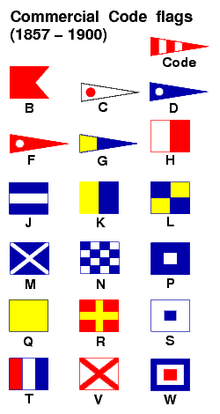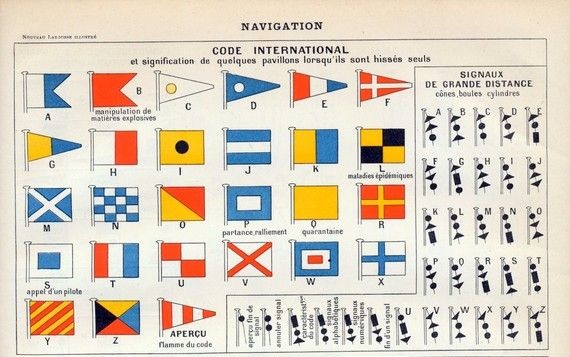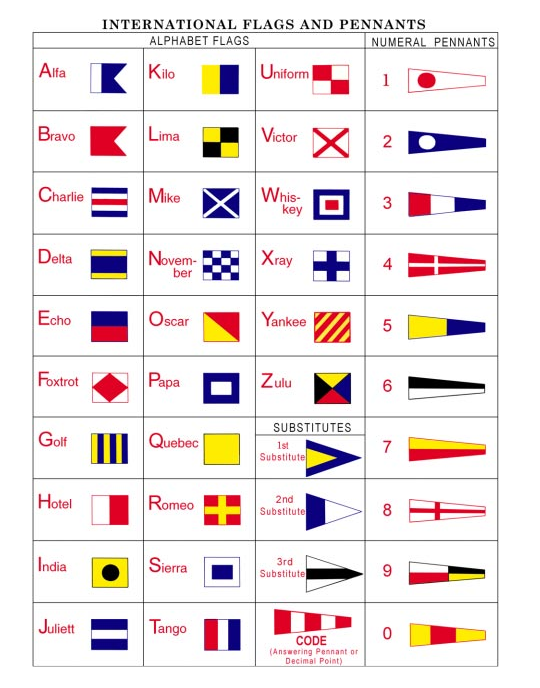International Code of Signals (ICS)
1857-1900
In 1855, the British Board of Trade drafted a new international standard for naval signaling flags. This new standard was published two years later in 1857, called the 'Commercial Code'. This was essentially the first version of the ICS. There were 18 flags (plus a code pennant) for the letters of the alphabet. Vowels and less commonly used letters were omitted (A E I O U, X Y Z).

1901-1931
The ICS went though some revising by the British Board of trade in 1887 and at the International Conference in 1889, and the new code was implemented worldwide in 1901. This code was majorly tested throughout World War I.
The new standard added back the missing letters from the previous set, now with all 26 letters (plus a code pennant). In 1920, a meeting, made by the allied powers, was held to try to create the Universal Electrical Communications Union. The creation of said organization never happened, but during the meeting, the phonetic spelling alphabet was added to the ICS.

This perticular diagram from the early 1900s is in French.
1932-Present
In 1927, the International Radiotelegraph Confrence, held at Washington in 1927, went over ideas for the new code, such as adding new languages to the standard. In 1932, the IRC held another meeting that added many new revisions. First, they added English, French, Italian, German, Japanese, Spanish, and Norwegian to the standard. They also added new codes for medical and aviation.
Many of the signal flags were changed too. The pennant flags for C, D, E, F, and G were replaced with new square flags to match the other letters. Numaric flags were also added. The old pennant flags for C, D, E, F, and G became 1, 2, 3, 4, and 5 respectively. New pennant flags were created for 6, 7, 8, 9, and 0. Finally, three new substitute flags were added.

This chart shows the newly changed flags. These are also the current that the navy and other ships use today. After 1932, other changes took place to parts of the international standard, but the flags themselves have stayed the same.
Meanings
Not only did each flag corrispond to a letter, but each flag had a meaning too. A flag would be hoisted up for other ships. This could tell others what's going on and if an action needs to be taken. The table below shows what each individual flag means. Flags could also be combine to mean many other things.
| Flag | ICS Stand Alone Flag Meaning |
| Alfa | "I have a diver down; keep well clear at slow speed." |
| Bravo | "I am taking in or discharging or carrying dangerous goods." |
| Charlie | "Affirmative." |
| Delta | "Keep clear of me; I am maneuvering with difficulty." |
| Echo | "I am altering my course to starboard." |
| Foxtrot | "I am disabled; communicate with me." |
| Golf | "I require a pilot." |
| Hotel | "I have a pilot on board." |
| India | "I am altering my course to port." |
| Juliet | "I am on fire and have dangerous cargo on board: keep well clear of me." or "I am leaking dangerous cargo." |
| Kilo | "I wish to communicate with you." |
| Lima | "You should stop your vessel instantly." |
| Mike | "My vessel is stopped and making no way through the water." |
| November | "Negative." |
| Oscar | "Man overboard." |
| Papa | In harbour: All persons should report on board as the vessel is about to proceed to sea. At sea: "My nets have come fast upon an obstruction." |
| Quebec | "My vessel is 'healthy' and I request free pratique." |
| Romeo | |
| Sierra | "I am operating astern propulsion." |
| Tango | "Keep clear of me." |
| Uniform | "You are running into danger." |
| Victor | "I require assistance." |
| Whiskey | "I require medical assistance." |
| Xray | "Stop carrying out your intentions and watch for my signals." |
| Yankee | "I am dragging my anchor." |
| Zulu | "I require a tug." |
